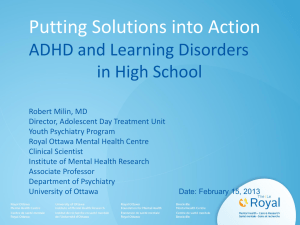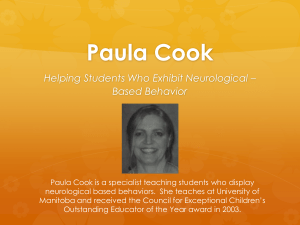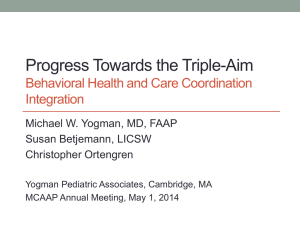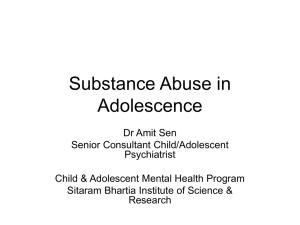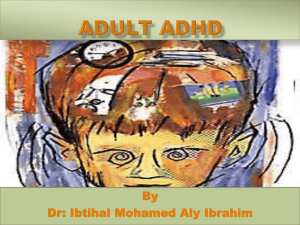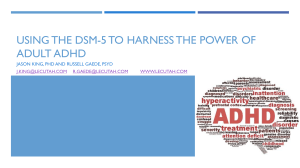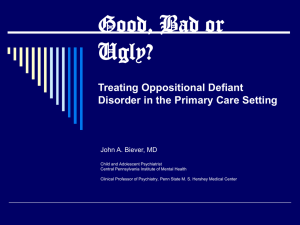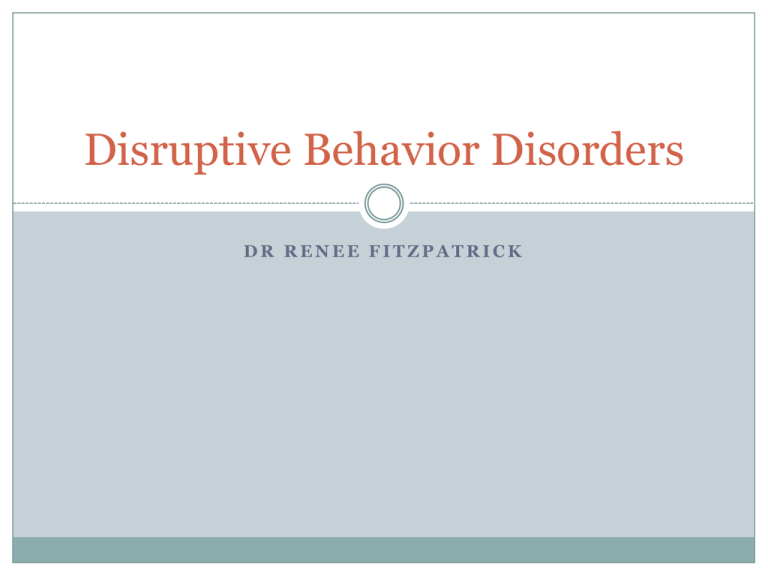
Disruptive Behavior Disorders
DR RENEE FITZPATRICK
Goals and Objectives
At the end of this presentation you will be able to:
1. Identify symptoms of disruptive behavior
disorders in childhood and adolescence.
2.Identify common comorbidities that complicate
diagnosis.
3.Know the biopsychosocial approach to treatment of
disruptive behavior disorders.
Disruptive Behavior Disorders
Attention Deficit Disorder
Oppositional Defiant Disorder
Conduct Disorder
ADHD Overview
ADHD is the most common neurobehavioral disorder
presenting for treatment in youth
Prevalence
6-8% youth worldwide; 4% of adults
Associated with impairment in multiple domains
Often comorbid with learning disabilities & psychiatric
illnesses including other disruptive behavior disorder
Treatment includes educational, psychotherapeutic, and
psychopharmacological interventions
(Goldman, JAMA:1998; Wilens et al Ann Rev Med, 2002;
Faraone et al., World Psych; 2003; Kessler et al, APA 04)
Twin Studies Show ADHD
Is a Genetic Disorder
Breast cancer
Asthma
Schizophrenia Height
Hudziak, 2000
Nadder, 1998
Levy, 1997
Sherman, 1997
Silberg, 1996
Gjone, 1996
Thapar, 1995
Schmitz, 1995
Edelbrock, 1992
Gillis, 1992
Goodman, 1989
Willerman, 1973
0
0.2
0.4
0.6
0.8
Average genetic contribution of ADHD based on twin studies
ADHD
Faraone. J Am Acad Child Adolesc Psychiatry. 2000;39:1455-1457.
Mean
Hemminki. Mutat Res. 2001;25:11-21.
Palmer. Eur Resp J. 2001;17:696-702.
1
Attention Deficit Hyperactivity disorder
Core features.
Hyperactivity
Inattention
Impulsivity
Onset before 7
Must be present in more than one setting
Must cause functional impairment
ADHD Clinical Subtypes
Predominantly inattentive:
• Easily distracted
• Not excessively hyperactive or impulsive in
behavior
Predominantly
Inattentive
20-30%
Predominantly hyperactive-impulsive:
• Extremely hyperactive and impulsive
• Not highly inattentive (may have no inattentive
signs)
• Often younger children
Combined type:
• Most patients
• All three classical signs of the disorder
50-75%
< 15%
Combined
Type
Predominantly
Hyperactiveimpulsive
Adapted from American Psychiatric Association, DSM-IV TR, 2000.
Diagnosis
ADHD is clinical diagnosis
Made by history and collateral
Psychometric tools supportive not diagnostic
Establish impairment/co-morbidities
Rule out medical conditions
Clinical presentation varies with age.
School Children
• Easily distracted
• Homework poorly organized, careless
errors, often incomplete or lost
• Low academic scores
• Frequent trips to the principal’s office •
• Blurts out answers before question
•
completed (often disruptive in class)
•
• Often interrupts and intrudes on
•
others
•
• Low self-esteem
•
•
Displays aggression
Difficult peer relationships
Does not wait turns in games
Often out seat
Perception of “immaturity”
Unwilling or unable to do chores at home
Accident prone
Greenhill LL. J Clin Psychiatry 1998;59 Suppl 7:31-41.
Adolescents
• May have sense of inner
restlessness rather than hyperactivity
• Procrastinates and displays
disorganized school work with poor
follow-through
•
•
•
•
•
•
Fails to work independently
Poor self-esteem
Poor peer relationships
Inability to delay gratification
Specific learning disabilities
Behavior not usually modified by
reward or punishment
• Engages in “risky” behavior
(speeding, unprotected sex,
substance abuse)
•
Apparent disregard for own safety
(injuries and accidents)
•
Difficulties or clashes with authority
Greenhill LL. J Clin Psychiatry 1998;59 (Suppl 7):31-41.
Domains of Function
Before
School
Difficulty
with:
Waking up
Getting
ready for
school
Struggling
excessively
with
parents
School
Difficulty
with:
Lower
grades
Lack of
focus
Disruptive
Difficulty
with
friendships
After School
Difficulty with
Bedtime
Difficulty
with:
Sports/Clubs:
Homework
Risky behavior
and injuries
Sitting through
dinner
Bedtime
prep
Settling
down and
falling
asleep
Family
interactions
1. Barkley RA, et al. J Am Acad Child Adolesc Psychiatry 1990;
29:546-556.
2. Barkley RA. J Clin Psychiatry 2002; 63(Suppl 12):S10-15.
3. DuPaul GJ, et al. J Am Acad Child Adolesc Psychiatry 2001;
40:508-515.
4. Greenhill LL. J Clin Psychiatry 1998; 59(Suppl 7):S31-41.
5. Weiss G, et al. J Am Acad Child Psychiatry 1985; 24:211-220.
To identify common comorbidities
In ADHD comorbidies are common and can
complicate treatment
Multiple Psychiatric Comorbidities
ADHD
ODD/CD
BPD
Tic
Learning
disorders
Depression/anxiety
disorders
Pliszka. Pediatr Drugs. 2003;5:741.
Co-Morbidities
Co-morbid disorders are very common with ADHD and
must be considered when planning treatment.
Commonest Co-morbidities:
Oppositional Defiant Disorder (ODD)
Conduct Disorder (CD)
Substance Abuse
Learning Disability
Oppositional Defiant Disorder (ODD)
Characterized by a pattern of negativistic, defiant,
disobedient and hostile behaviors, at least 6 month
duration and 4 out of 8 of the following:
often loses temper
often argues with adults
often actively defies rules or refuses to comply
often deliberately annoys other people
often blames others for mistakes
often touchy or easily annoyed by others
often angry and resentful
often spiteful and vindictive
Oppositional Defiant Disorder (ODD)
Causes clinically
significant impairment in
social, academic or
occupational functioning
Doesn’t occur exclusively
during psychotic or mood
disorder
Doesn’t meet criteria for
conduct disorder
Conduct Disorder (CD)
… pattern of violating the rights
of others and/or major social
norms, in the past twelve
months, in at least 3 of the
following:
Aggression to people and
animals
Destruction of property
Deceitfulness or theft
Serious violation of rules
Learning Disabilities
Need to be identified and accommodations made
informed by testing
Some of the co-morbidities can complicate
treatment planning…
Tourette’s Syndrome
Sleep Disorders
Anxiety Disorders
Learning Disability
Hearing Problems
Pervasive Developmental Disorder
•Side effects from meds
•Measuring treatmen response
Why Treat ADHD?
Interpersonal problems / family conflict/peer
difficulties
Associated psychopathologies
2-3 times greater risk for depression
3 times greater risk for substance abuse
Vocation-related problems:
Higher rate of high school drop out
Higher rates of absenteeism
productivity
↑ Rate of legal difficulties, traumatic injury,
accidents
Multimodal Treatment of ADHD
Psychoeducation
Medications:
Stimulants vs Non-stimulants
Agents for co-morbid disorders
Psychotherapy
Individual: CBT
Family Therapy
Social skills training
Educational/vocational planning
Educating the Patient/Parent
Identify target symptoms
Outline risks and benefits of
various medication options
Discuss the psychosocial and
behavioral treatment
Inform about risks of not treating
Multimodal Treatment Study of Children with Attention Deficit
Hyperactivity Disorder (or MTA)
The MTA included 579 elementary school boys and girls with
ADHD. Four programs were compared:
(1) medication management alone
(2) behavioral treatment alone
(3) a combination of both
(4) routine community care.
Best improvements: Group (1) and (3)
Combined treatment led to the biggest improvements in anxiety,
academic performance, oppositionality, parent-child relations,
and social skills
Some children in the combined group could be successfully
treated on lower does of medication than those on medication
alone.
Choosing an agent
What co-morbid illnesses are present?
Medical
Psychiatric (anxiety, tics, substance abuse)
When is symptom control required? (coverage in the
evening hours)
What medications have already been tried?
Is there a family member that has had good results
with a particular agent?
Choosing an agent
How quickly does symptom control have to occur?
(urgency of situation)
Affordability (what is covered by their drug plan?)
What other non-Adhd medications is the person
taking?
Are the logistics of swallowing pills an issue?
CADDRA Recommendations
Long acting agents will be first line
Across the lifespan but particularly for adolescents and adults
Short acting agents will be considered adjuvant
treatments in the first line
CADDRA Guidelines for
Pharmacological Treatment of ADHD
1st line
Long Acting
+
Approved by
Health Canada
Adderall XR
(Biphentin)
Concerta
Strattera
2nd line
Short Acting
+
Approved by
Health
Canada
Dexedrine
DexSpansules
Ritalin
Ritalin-SR
CADDRA. Canadian ADHD Practice Guidelines. www.caddra.ca.
3rd line
"Off label"
if drugs fail
Imipramine
Wellbutrin
SR
(Wellbutrin
XL)
Management of ADHD
Side Effects of Stimulants:
Loss of appetite
Headache
Mood lability
insomnia
tics
abdominal pain
tachycardia
hypertension
growth suppression
Rarely Psychotic Symptoms
Co-morbid Oppositional Defiant Disorder
• Both
stimulants and ATX reduce it markedly if ADHD comorbid
Parent training in behavior management
methods more effective< 13
Problem-solving skills/ social skills training
explosive anger may require use of atypical antipsychotics or
antihypertensives
Co-morbid conduct disorder
• Stimulants and ATX may reduce aggressive behavior and
antisocial acts due to co-morbid impulsivity
Atypicals antipsychotics (risperidone) or antihypertensives may be
needed for highly aggressive youth
• Parent and family interventions o required
– Problem-solving, communication training – Multi-systemic
therapy where available
• Involvement of juvenile justice agencies likely
What To Do When Parents Believe That
Treatment Is Unnecessary
Discuss the side effects and potential risks
of
treatment
Educate parents on the risks of not treating
Together, compare the pros and cons of treatment
versus non-treatment
If parents insist against treatment, chart
they have taken this decision despite
discussion of the risks of non-treatment
medico-legal reasons)
that
a
(for
Managing Sleep Disturbances
ADHD Patients
Clarify the history of the sleep problem
in
(i.e. is it
related to medication?)
Review sleep hygiene and make recommendations, if
necessary
Consider non-medical treatment (e.g. tryptophan,
melatonin)
Consider low-dose clonidine once-daily
Consider atypical neuroleptics if management
aggressive behaviour is needed
of
Psychosocial interventions. Necessary for
effective treatment
Education.
Structured consistent environment
Parent training
Organizational skills
School accommodations
Self regulation. Social skills training
Summary
Highly co morbid diagnoses.
High morbidity untreated.
Multimodal treatment most effective.



